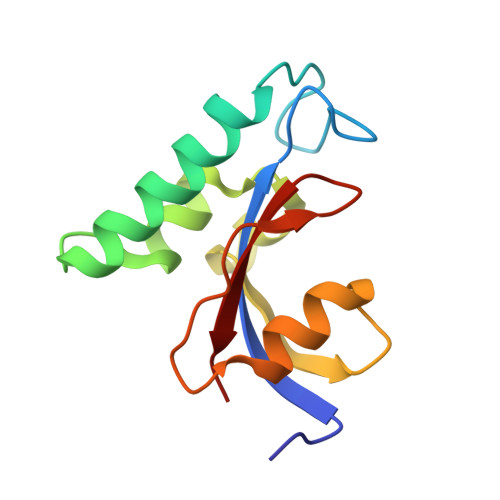Structural Analysis of the Mitotic Regulator hPin1 in Solution: INSIGHTS INTO DOMAIN ARCHITECTURE AND SUBSTRATE BINDING.
Bayer, E., Goettsch, S., Mueller, J.W., Griewel, B., Guiberman, E., Mayr, L.M., Bayer, P.(2003) J Biological Chem 278: 26183-26193
- PubMed: 12721297
- DOI: https://doi.org/10.1074/jbc.M300721200
- Primary Citation of Related Structures:
1NMV, 1NMW - PubMed Abstract:
The peptidyl-prolyl cis/trans isomerase hPin1 is a phosphorylation-dependent regulatory enzyme whose substrates are proteins involved in regulation of cell cycle, transcription, Alzheimer's disease, and cancer pathogenesis. We have determined the solution structure of the two domain protein hPin1-(1-163) and its separately expressed PPIase domain (50-163) (hPin1PPIase) with an root mean square deviation of <0.5 A over backbone atoms using NMR. Domain organization of hPin1 differs from that observed in structures solved by x-ray crystallography. Whereas PPIase and WW domain are tightly packed onto each other and share a common binding interface in crystals, our NMR-based data revealed only weak interaction of both domains at their interface in solution. Interaction between the two domains of full-length hPin1 is absent when the protein is dissected into the catalytic and the WW domain. It indicates that the flexible linker, connecting both domains, promotes binding. By evaluation of NOESY spectra we can show that the alpha1/beta1 loop, which was proposed to undergo a large conformational rearrangement in the absence of sulfate and an Ala-Pro peptide, remained in the closed conformation under these conditions. Dissociation constants of 0.4 and 2.0 mm for sulfate and phosphate ions were measured at 12 degrees C by fluorescence spectroscopy. Binding of sulfate prevents hPin1 aggregation and changes surface charges across the active center and around the reactive and catalytically essential Cys113. In the absence of sulfate and/or reducing agent this residue seems to promote aggregation, as observed in hPin1 solutions in vitro.
- Max-Planck-Institute for Molecular Physiology, Otto-Hahn-Strasse 11, 44227 Dortmund, Germany.
Organizational Affiliation:

















